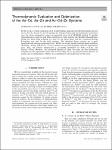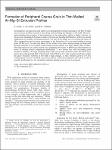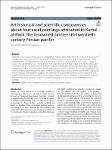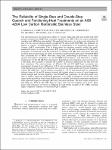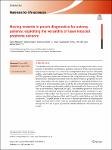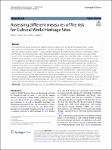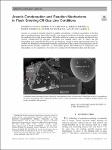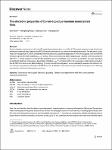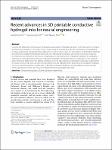Search
Author
- Manyk, T. (3)
- Murawski, K. (3)
- Baumgartner, Jörg (2)
- Guizani, Chamseddine (2)
- next >
Subject
Date issued
- 2023 (187)
Has File(s)
- true (187)
Search Results
In this work, a critical evaluation of all available phase diagrams and thermodynamic data for the As–Cd, As–Zn and As–Cd–Zn systems has been performed and thermodynamic assessments over the whole composition ranges are presented using the CALPHAD method. To predict thermodynamic properties and phase equilibria for these systems, the Modified Quasichemical Model for short range ordering was used for the liquid phase and the Compound Energy Formalism was used for the solid solutions. The optimized binary systems are in good agreement with existing experimental data. Within the ternary system predicted phase equilibria, the ZnAs2−CdAs2
and Zn3As2−Cd3As2
sections are in good agreement with the experimental data. Also, the eutectic temperature is accurately optimized for ZnAs2−Cd3As... |
Investigations on microstructure and texture development during processing of Al–Mg–Si sheet and extrusion profiles focused on describing and modelling the changes in the bulk. However, understanding the evolution of microstructure in the sub-surface region is highly relevant, as this governs material performance under corrosion and bending deformation, which are crucial applications in mobility and transportation. The aim of this study was to correlate the effect of alloy composition and extrusion parameters to the formation of texture and peripheral coarse grain (PCG) layer. For this, five alloys of the AA6xxx class with varying content of dispersoid forming elements were extruded at increasing extrusion speeds into thin-walled hollow profiles. The microstructure at a plane sectio... |
Pigments on four easel paintings signed by Mohammad Ghaffari (latter Kamal al-Molk), the renowned Persian painter lived from the mid-nineteenth to the mid-twentieth century, kept at the Astan-e Qods-e Razavi Museum (AQRM) in Mashhad, Iran, were identified by micro-X-ray fluorescence (µ-XRF), scanning electron microscopy—energy dispersive X-ray spectrometry (SEM–EDS) and micro-Raman spectroscopy (µ-Raman). Apart from chrome yellow, green chromium oxide and red ochre, four blue pigments including Prussian blue, artificial ultramarine blue, azurite, blue phthalocyanine PB:16 and seven white pigments including rutile, huntite, lead white, baryte, chalk, gypsum and zinc white were identified on the paintings. Based on the occurrence of rutile and blue phthalocyanine PB:16 and the fact th... |
The microstructural and mechanical effects of various single-step (SS) and double-step (DS) quench and partition (Q&P) heat treatments applied to an AISI 420A low carbon martensitic stainless steel (MSS) has been studied. The goal with this work is to reach a total elongation (E pct) of 12 pct and an ultimate tensile strength (UTS) above 1200/1300 MPa, but ultimately to achieve a superior strength-ductility balance in comparison to its traditional Quench and Temper (Q&T) counterpart. This is being done by retaining austenite within the steel’s martensitic matrix at room temperature (RT) using novel SS and conventional DS Q&P heat treatments. Considerable work has been done to optimize DS Q&P heat treatments, but little has been done to understand the effects of removing a subsequent... |
The development of a 3D printed sensor for direct incorporation within stoma pouches is described. Laser induced graphene scribed on either side of polyimide film served as the basis of a 2 electrode configuration that could be integrated within a disposable pouch sensor for the periodic monitoring of ileostomy fluid pH. The graphene sensors were characterised using electron microscopy, Raman spectroscopy, DekTak profilometry with the electrochemical properties investigated using both cyclic and square wave voltammetry. Adsorbed riboflavin was employed as a biocompatible redox probe for the voltammetric measurement of pH. The variation in peak position with pH was found to be linear over pH 3–8 with a sub Nernstian response (43 mV/pH). The adsorbed probe was found to be reversible a... |
This study aims to assess whether two publicly available sources of fire threats to 346 Cultural World Heritage Sites across Europe substitute or complement each other. By doing so, a novel measure based on information from the UNESCO periodic report II is created and benchmarked against the European forest fire information system (EFFIS) index. The UNESCO periodic report shows that forest fires are perceived as an actual or foreseeable hazard by 40% of the management of Cultural World Heritage Sites in Europe. When the EFFIS index is linked to the UNESCO World Heritage database, it occurs that 48% of these sites are at high risk of fire, 31% at medium risk and 21% at low risk. Results based on Probit and Fractional Probit estimations reveal that the perceived fire risk relates to s... |
Arsenic is a common impurity element in sulfide concentrates. It tends to accumulate in the flue dust of smelting furnace due to the volatility and internal circulation of the flue dust practiced in the smelting-converting process chain. The only outlets for arsenic are anodes and discard slag. Arsenic condensation in dust-free conditions was studied below 800 °C where the gas atmosphere was controlled by SO2-air-N2 gas mixtures. Based on these experimental results, we confirm the kinetically constrained formation mechanism of the arsenic-containing dust, and its speciation into metallic, oxidic (III, V), and sulfidic species. The influences of temperature and atmosphere on the speciation of arsenic were compared with industrial data and discussed. |
Various doping concentrations of boron (B)-doped germanium nanocrystal (Ge NC) films were prepared using the plasma-enhanced chemical vapor deposition (PECVD) technique followed by thermal annealing treatment. The electronic properties of B-doped Ge NCs films combined with the microstructural characterization were investigated. It is worthwhile mentioning that the Hall mobilities μHall
of Ge NCs films were enhanced after B doping and reached to the maximum of 200 cm2 V−1, which could be ascribed to the reduction in surface defects states in the B-doped films. It is also important to highlight that the temperature-dependent mobilities μH(T)
exhibited different temperature dependence trends in the Ge NCs films before and after B doping. |
In the growing area of neuromorphic and in-memory computing, there are multiple reviews available. Most of them cover a broad range of topics, which naturally comes at the cost of details in specific areas. Here, we address the specific area of multi-level resistive switching in hafnium-oxide-based devices for neuromorphic applications and summarize the progress of the most recent years. While the general approach of resistive switching based on hafnium oxide thin films has been very busy over the last decade or so, the development of hafnium oxide with a continuous range of programmable states per device is still at a very early stage and demonstrations are mostly at the level of individual devices with limited data provided. On the other hand, it is positive that there are a few d... |
Recently, the 3D printing of conductive hydrogels has undergone remarkable advances in the fabrication of complex and functional structures. In the field of neural engineering, an increasing number of reports have been published on tissue engineering and bioelectronic approaches over the last few years. The convergence of 3D printing methods and electrically conducting hydrogels may create new clinical and therapeutic possibilities for precision regenerative medicine and implants. In this review, we summarize (i) advancements in preparation strategies for conductive materials, (ii) various printing techniques enabling the fabrication of electroconductive hydrogels, (iii) the required physicochemical properties of the printed constructs, (iv) their applications in bioelectronics and ... |

